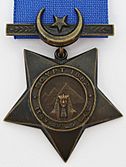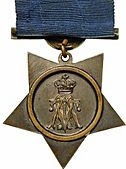Khedive's Star facts for kids
Quick facts for kids Khedive's Star |
|
|---|---|
 
Khedive's Star: obverse and reverse
|
|
| Type | Campaign medal |
| Eligibility | Egyptian, British and Indian forces. |
| Campaign(s) | Anglo-Egyptian War Mahdist War |
| Statistics | |
| Established | 1882 |
| Related | Egypt Medal Khedive's Sudan Medal (1897) Khedive's Sudan Medal (1910) |
 Ribbon bar of the medal |
|
The Khedive's Star was a special medal given out in Egypt and Sudan. It was created by the leader of Egypt, Khedive Tewfik Pasha. This medal was given to soldiers who fought in important wars in Egypt and Sudan between 1882 and 1891. This included soldiers from Britain and India. They often received this medal along with another British medal called the Egypt Medal. The Khedive's Star was made of bronze and looked like a star. It is sometimes called the Khedive's Bronze Star.
History of the Khedive's Star
In 1882, a war broke out in Egypt. It was called the 1882 Anglo-Egyptian War. A leader named Ahmed ‘Urabi wanted Egypt to be independent. The British helped the Egyptian leader, Khedive Tewfik Pasha, who supported them.
After the British won the war, Khedive Tewfik Pasha decided to reward the soldiers. He wanted to thank all the British and Indian Army soldiers who helped in the fight. These soldiers had also received the British Egypt Medal. The Khedive gave them permission to wear his new star on their uniforms.
The Khedive's Star was also given for later battles. These battles were part of the Mahdist War in Sudan. The medal was awarded for service up until 1891. When the British and Egyptians started to take back Sudan in 1896, the Khedive created a new medal. This new medal was called the Khedive's Sudan Medal (1897).
The Khedive also gave a few of these stars to Egyptian civilians. These people received the medal for non-military work.
What the Khedive's Star Looks Like
The Khedive's Star is a five-pointed star made of bronze. It was darkened with a special coating. On the front of the star, you can see a picture of the Sphinx. Behind the Sphinx are the famous pyramids. This picture is inside a circle that says "EGYPT" and shows the year. The same words are also written in Arabic.
On the back of the star, you can see the special symbol of Tawfiq Pasha. This symbol is called a monogram and has a crown above it. The medal hangs from a dark blue ribbon. The bar that holds the ribbon has a crescent moon and a star design. The medals were given out without names on them. However, some soldiers paid to have their names carved on the back.
The company that made these medals was Henry Jenkins and Sons. They were located in Birmingham, England. This company also made another famous medal called the Kabul to Kandahar Star in 1880.
Different Khedive's Star Versions
There were four different versions of the Khedive's Star. Each version was for a different time period or campaign. Soldiers only received one star, which was for their earliest service.
- Dated 1882: This star was given for fighting in the 1882 Anglo-Egyptian War. This war was fought to support the Khedive.
For service in Sudan during the Mahdist War, there were other versions:
- Dated 1884: This star was for battles between February 19 and March 26, 1884. These battles were part of the first Suakin Expedition.
- Dated 1884-6: This version was for battles from March 26, 1884, to October 7, 1886. This included the Nile expedition to help General Gordon. He was trapped in Khartoum. It also included battles near Suakin in 1885.
- Undated: This star was for battles from 1887 to 1891. Most of these fights were near Suakin and along the Nile River.
There was also a special Tokar clasp. This clasp was a small bar that could be added to the ribbon. It had the word "Tokar" written in Arabic. It was given to soldiers who fought at Tokar on February 19, 1891. If a soldier already had a Khedive's Star, they added this clasp to it. If they were new recipients, they received an undated star with the clasp.
British soldiers who received the Khedive's Star almost always also received the Egypt Medal. The only exception was for service at Tokar in 1891. For that battle, the Egypt Medal was not given out.


